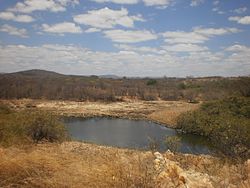Biology:Nymphaea caatingae
| Nymphaea caatingae | |
|---|---|
| Scientific classification | |
| Kingdom: | Plantae |
| Clade: | Tracheophytes |
| Clade: | Angiosperms |
| Order: | Nymphaeales |
| Family: | Nymphaeaceae |
| Genus: | Nymphaea |
| Species: | N. caatingae
|
| Binomial name | |
| Nymphaea caatingae C.T.Lima & Giul.[1]
| |

| |
| It is endemic to Northeast Brazil[1] | |
Nymphaea caatingae is a species of waterlily endemic to Northeast Brazil.[1]
Description
Vegetative characteristics
Nymphaea caatingae is an aquatic herb.[2] It has stoloniferous, subglobose tubers. The floating leaves are attached to the stem by glabrous, non-brittle, 2.3-8 mm wide,green to reddish petioles, which have two primary central air canals, as well as six smaller secondary ones.[3] The leaf blade is ovate, suborbicular to orbicular in shape and has flat and entire margins.[2] The apex of the leathery lamina is obtuse.[3]
Generative characteristics
Flowering occurs throughout the year.[3] The nocturnal flowers float on the water surface.[2] They have non-brittle, glabrous, brownish peduncles with six central primary air canals and twelve smaller secondary, peripheral ones.[3] There is an abrupt transition from the white petals to stamens and staminodia are absent.[2] The ellipsoid, ruminate, pilose seeds have trichomes arranged in interrupted, longitudinal lines.[2]
Reproduction
Vegetative reproduction
Proliferating pseudanthia are present,[2] which enable rapid vegetative reproduction under volatile environmental conditions.[4] Stolons are produced as well, but the proliferating pseudanthia are the main mode of vegetative propagation.[3]
Generative reproduction
The nocturnal, protogynous flowers last for two days. Autogamy does not occur. Fruit set has only been observed after cross pollination.[3]
Taxonomy
It was first described by C.T.Lima and Ana Maria Giulietti in 2021.[1]
Type specimen
The type specimen was collected by C.T. Lima on the 13th of December 2009 in the municipality Itaberaba on the road to Ipirá in the state of Bahia, Brazil.[3]
Placement within Nymphaea
It is placed in Nymphaea subgenus Hydrocallis. It is morphologically closest to Nymphaea vanildae.[3]
Etymology
The specific epithet caatingae refers to the Caatinga.[3]
Ecology
Habitat

In the Caatinga, it grows in temporary ponds, and in stagnant water.[3] It is endemic to Brazil and occurs in the Caatinga, as well as the Atlantic rainforest.[2]
References
- ↑ 1.0 1.1 1.2 1.3 "Nymphaea caatingae C.T.Lima & Giul." (in en). Royal Botanic Gardens, Kew. http://www.plantsoftheworldonline.org/taxon/77295790-1. Retrieved 8 December 2023.
- ↑ 2.0 2.1 2.2 2.3 2.4 2.5 2.6 Pellegrini, M. O. O. & Jardim Botânico do Rio de Janeiro. (n.d.). Nymphaea caatingae C.T.Lima & Giul. Flora E Funga Do Brasil. Retrieved December 8, 2023, from https://floradobrasil.jbrj.gov.br/FB623375
- ↑ 3.00 3.01 3.02 3.03 3.04 3.05 3.06 3.07 3.08 3.09 de Lima, C. T., Machado, I. C., & Giulietti, A. M. (2021). "Nymphaeaceae of Brasil." Sitientibus série Ciências Biológicas, 21.
- ↑ de Queiroz, L. P., Cardoso, D., Fernandes, M. F., & Moro, M. F. (2017). "Diversity and evolution of flowering plants of the Caatinga domain." Caatinga: the largest tropical dry forest region in South America, 23-63.
Wikidata ☰ Q123705504 entry
 |

